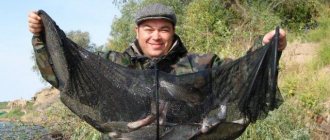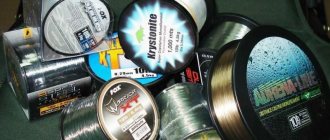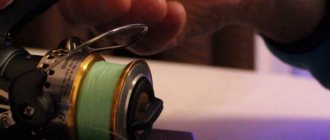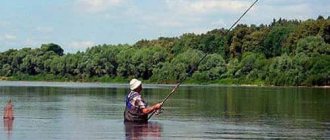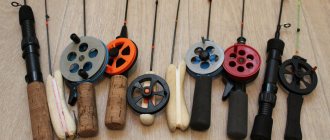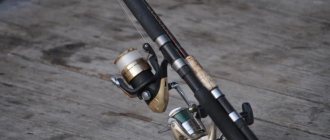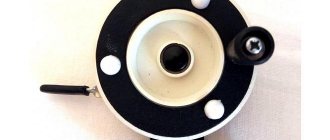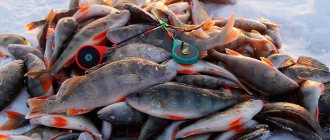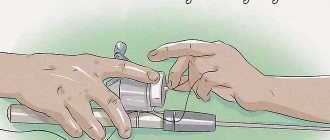How to choose a fishing line for spinning
Contrary to the general belief that spinning is the most important and main element of equipment for productive fishing, without fishing line this procedure would make absolutely no sense. Therefore, as in the case of fishing rods, the choice of fishing line must also be approached thoroughly. What should you pay attention to?
- Line diameter.
A parameter that affects the casting characteristics, the visibility of the thread in the water and its amount on the reel spool. Selected based on your own preferences and purpose (usually by trial and error). - Breaking force
. A criterion showing what loads a fishing line can withstand without breaking. As a rule, before going on sale, all polymer threads undergo a series of laboratory tests. You should not sincerely believe the figures obtained during such tests, since they show the capabilities of the sample under ideal conditions. In real fishing, the ability of a fishing line to withstand loads is affected by many factors, including the angle at which the spinning rod is held, the composition and temperature of the water, as well as various landscape features (sharp rocks, shell rock, etc.). Always consider this before purchasing. - Unwinding amount
. The choice according to this criterion involves many nuances, including the preferred location (size and depth of reservoirs) and type of fishing (jigging, twitching, etc.). The range of products in fishing stores is replete with fishing lines with a length of 50 to 300 meters. But the most popular option was and remains the samples with an unwinding of 100-150 meters, so it is better to give priority attention to them. - Stiffness
. Criterion-characteristic of the degree of strength of a fishing line. The soft polymer thread does not cause alertness among river inhabitants, but has the ability to stretch, get tangled when hooked, and age, which at a critical moment can lead to an unexpected break right at the moment of fishing. Rigid fishing line is suitable for fishing with heavy wobblers and other “nimble” baits, but it is also not without its drawbacks. It is much more difficult to come off the reel, has weak shock absorption, breaks when bent and does not lend itself to tying strong knots. - Transparency.
A parameter that greatly influences fishing efficiency. When choosing fishing line, give preference to colorless or “rainbow” samples that change color when immersed in water. It is very important that the polymer thread does not stand out too much against the background of the water (ideally, it should completely merge with the bottom).
All the pros and cons of braided fishing line
Braided fishing line has all the strength characteristics superior to monofilament, has increased abrasion resistance, and has no stretching or residual deformation. These qualities allow it to be used effectively in spinning fishing and trolling fishing, where the balance of pros and cons, when choosing the required set of properties, leans in its favor.
Some properties, the origin of which braided fishing line owes to its special multi-core structure, are not in its favor:
- the high drag coefficient, which prevents long casting, does not allow it to be used effectively with light baits;
- The specific weave of the fibers of a braided cord allows solid particles that fall on the cord during fishing to get stuck in them, thereby increasing the abrasiveness of the fishing line. This fact entails rapid abrasion and wear of the guide rings of the rod and the line roller of the reel;
- weak camouflage properties are reflected in the results of catching cautious fish;
- the high price of the product limits the possibility of its alternative use;
- increased tendency for knots to twist and tangle causing inconvenience.
Rating of the best fishing lines
| Nomination | place | Name of product | price |
| The best monofilament lines | 1 | Daiwa Ginro Silver Beast Nanodis | 500 rub. |
| 2 | Salmo Tournament Team | 320 rub. | |
| Best Fluorocarbon Lines | 1 | Sufix Castable 100% Fluorocarbon Clear 150 m | 1,120 RUB. |
| 2 | Megabass Dragoncall Black Jungle | 1,640 RUB. | |
| 3 | Salmo Fluorocarbon Troutino Soft 150m | 830 RUB. | |
| 4 | Berkley Trilene 100% fluorocarbon | 440 RUB. | |
| The best fishing lines for a feeder | 1 | Colmic Blade Sinking 150m 0.230mm | 505 RUB. |
| 2 | Kosadaka Cinergy 110m 0.25mm | 1,920 RUB. | |
| 3 | Cralusso Feeder & Carp Fishing Line 150m 0.22mm | 430 RUB. | |
| The best fishing line for leashes | 1 | Sufix Kameleon 20m 7kg | 800 RUB. |
| 2 | Cralusso Feeder & Carp Braided Hooklength Sinking 10m 20lb | 535 RUB. | |
| Best Fishing Lines for Carp | 1 | FOX Torque Line Green | RUB 1,099 |
| 2 | CLIMAX CULT CARP LINE Z-SPORT | 1,640 RUB. | |
| 3 | Korda Touchdown | RUB 2,819 | |
| The best fishing lines for pike | 1 | SHIMANO ASPIRE SILK SHOCK 150 m, 0.20 mm | 480 rub. |
| 2 | SUFIX DURAFLEX CLEAR 100 m 0.25 mm | 300 RUB. | |
| 3 | SHIMANO TECHNIUM LINE 200 m 0.18 mm | 1,040 RUB. | |
| The best winter fishing lines for jigs | 1 | Salmo Ice Power | 196 RUB. |
| 2 | Berkley FireLine Micro Ice Fused Original | 350 RUB. | |
| 3 | SUFIX ICE MAGIC | 160 rub. |
The best monofilament lines
Daiwa Ginro Silver Beast Nanodis
Daiwa Ginro Silver Beast Nanodis can be considered a leader in the quality-to-price ratio component. Daiwa loves to experiment with various aspects of its equipment, but this series was presented as a focused, non-distracted creation designed to improve fishing performance during the summer season.
Monofilament fishing line is characterized by a very high breaking load (up to 5.4 kilograms), which is achieved through precise calibration of the diameter along the entire length. It holds the knot well and, as the manufacturers assure, has virtually no memory effect. The latter, however, was refuted by the fishermen themselves - total bends do not appear on the monofilament, but it remembers the outlines of the accepted shape well. The main types of bait that are ideally combined with the Ginro Silver Beast Nanodis are wobblers (to a lesser extent), tails and spinners.
Advantages
high values of breaking loads (for fishing line with a diameter of 0.285 mm - 5.4 kg);
precise calibration throughout the entire unwinding;
high catchability (mainly trout);
characteristic yellow color, merging with water.
Features of choosing fishing line
The choice of monofilament fishing line is dictated by the planned method of fishing. So, when fishing with a spinning rod using uniform strokes when fishing short distances, a regular monofilament cord, suitable for the expected diameter and breaking load of the trophy, is quite justified. For float rods of any type, fishing line is the classic type of cord.
Leaders are made from monofilament for almost all types of fishing. And the combination of a hard quivertip and monofilament line allows you to assemble sensitive tackle. Also, when choosing a suitable cord, be sure to pay attention to the volume of the bobbin or the length of the thread, which should exceed the fishing distance in size, since tying the material with the aim of increasing its length is not an entirely acceptable option, which reduces the reliability of any type of gear.
Which fishing line is better to choose for winter fishing?

The harsh Russian winter is not a reason for keen fishermen to stay at home. We select warm equipment, tackle and go ahead – entice wary fish to bite. The temperature regime dictates its own rules. And fishing line for winter fishing must be selected according to certain criteria.
Strength with small diameter . We interviewed our experts, and everyone put strength (including at knots) first. However, the fishing line must be thin. Firstly, the fish is “capricious”. She is distrustful of the baits offered and looks closely at the “treat” before attacking. The thicker and more visible the line, the more likely it is that the fish will get scared. Secondly, in winter light, miniature baits are used, and too thick a diameter will simply ruin the game. So, a good fishing line for winter fishing is thin and strong . The diameter can be neglected in spring, when the fish feed intensely and greedily before spawning. The standard diameter for winter is 0.1 - 0.12 mm. The exception is when fishing with a girder, then you can use a fishing line with a thickness of 0.35 mm.
In second place is the lack of memory. The line should not curl. This property is also relevant in the summer, but when fishing from ice, coils on monofilament simply do not allow you to fully control the bait. This quality is also important when fishing for pike perch. In winter it occurs at considerable depth. Therefore, specifically for hunting fanged predators, a rigid fishing line is preferable, but without a “memory effect” in order to feel bites. For other types of fish, softer monofilament thread can be used.
The third point is invisibility . Yes, it also depends on the diameter. But in this case we are talking about the transparency of water in reservoirs in winter. That’s why fluorocarbon and fluorocarbon-coated fishing lines are popular for ice fishing.
Cons of monofilament
Progress in the chemical industry does not stand still, crowding out monofilament in popularity with other types of polymer cords. As a result of this competition, classic fishing lines lose in terms of the ratio of strength to diameter of the material, and also have high stretch coefficients, which reduces the sensitivity of the equipment, especially when fishing at long distances, as well as the ability to tightly control the bait when making retrieves.
The synthetic product is sensitive to ultraviolet radiation, losing its basic qualities and, in particular, strength, and often has a memory that is not entirely necessary for fishing threads, completely losing its original shape, imitating the bobbin of a reel or holder on which the cord is wound.
Best Fluorocarbon Lines
Sufix Castable 100%!Fluorocarbon Clear 150 m
The Sufix company, which has received national recognition, has pleased fishing enthusiasts with a durable fluorocarbon series, suitable both for tying leashes and for use as the main line for fishing. Objectively, Castable 100%!Fluorocarbon Clear is the most versatile thread of all in this category, for a number of reasons. Firstly, it is worth highlighting the increased resistance of the material to water jets, UV rays and cutting effects from the sharp teeth of predators. Secondly, the stretch of fluorocarbon is an order of magnitude less than that of standard monofilament. Thanks to this set of qualities, this thread is ideal for twitching (as it prevents baits from being shot) and lures, allowing you to feel the bait throughout the entire wiring process.
The issue of price in the case of Sufix Castable 100%!Fluorocarbon Clear is not even considered: the monofilament more than compensates for the costs with efficiency and durability, which is very pleasant for fishing enthusiasts.
Advantages
balance of cost and quality parameters;
high degree of resistance to negative factors;
wide range of maximum perceived loads (from 1.5 to 9 kilograms);
Flaws
- not detected.
Megabass Dragoncall Black Jungle
The remarkableness of the thread of this series in retail sale is due to the fact of its unusual color. Megabass Dragoncall Black Jungle is a unique black fluorocarbon used primarily for carp fishing as a main line. Despite the high degree of rigidity, it shows satisfactory results in terms of elasticity and flexibility, due to which it holds knots well and does not break on bends. It appears on the market in three versions: hundred-meter unwindings of 0.235 and 0.285 in cross-section and a 0.400-mm “heavyweight” with a length of 80 meters, capable of withstanding up to nine kilograms of constant load.
Dragoncall Black Jungle is not too fond of fishing in shallow waters and in the upper layers of reservoirs, as it causes wariness in the fish. Its element is significant depressions where the thread almost completely merges with the bottom surface. Thanks to its resistance to abrasive wear, the service life of the Jungle can reach 3-5 seasons, even under the condition of periodic heavy loads and gradual accumulation of fatigue.
Advantages
ability to withstand up to nine kilograms of breaking load;
suitability for carp fishing;
combination of rigidity, elasticity and flexibility;
strong knots and wear resistance.
Flaws
- a specific color that alerts fish in the upper layers of water.
Salmo Fluorocarbon Troutino Soft 150m
The Salmo company did not stand aside either, offering consumers the expectedly “strong” fluorocarbon at an attractive price. Troutino Soft has proven itself as a reliable leash material that can withstand significant short-term loads. The dynamic breaking force of the thread of the largest cross-section (0.28 mm) is 5.5 kilograms, which in itself is not so much. However, the reserve of “critical” strength makes it possible to withstand peak loads of the order of 9-10 kilograms, for which this thread is valued as a leash.
Another characteristic feature of Troutino Soft is its increased softness and, as a result, some tendency to stretch. But on the other hand, with such inputs, it holds the knot well and allows you to achieve that same effect of peak tensile forces.
Monofilament storage requirements
Even despite the high positions in the rating of monofilament fishing line of individual models and manufacturers, we note the fact that all accessories are susceptible to destruction from exposure to ultraviolet radiation or direct sunlight.
https://www.youtube.com/watch?v=gVD4eGcUxvU
Also, fishing lines are afraid of high temperatures, which dry out the structure and make it fragile. High humidity, on the contrary, loosens the material, reducing the reliability of the thread. In all cases, the optimal option for storing reels is to keep the wood at normal room temperature and humidity in boxes closed from light.
